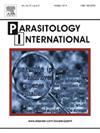A systematic review of the genus Tyzzeria Allen, 1936 (Chromista: Apicomplexa), including the molecular phylogenetic position of Tyzzeria parvula (Kotlán, 1933) Klimeš, 1963
IF 1.5
4区 医学
Q3 PARASITOLOGY
引用次数: 0
Abstract
Tyzzeria Allen, 1936 is a coccidian genus traditionally associated with Anseriformes, although there are descriptions of Tyzzeria spp. from junglefowls, snakes, skinks and mice. In this sense, the current study performs a taxonomic review of Tyzzeria spp., evaluating those that should be valid, invalid or that require further studies for validation. Along with this review, oocysts morphologically identified as Tyzzeria parvula (Kotlán, 1933) Klimeš, 1963 were recovered from fecal samples of swan geese Anser cygnoid (Linnaeus, 1758) in the mountainous region of the State of Rio de Janeiro, which were molecularly identified through the sequencing of a locus of the small subunit ribosomal RNA (18S) gene, providing the first deposit of the genus Tyzzeria in GenBank. Finally, this sequence of T. parvula prompted a broad phylogenetic analysis covering species of the main chromist taxa, which evidenced homoplasies associated with taxonomic characters of gametogony, basic oocyst configuration and excystation structures; in addition to positioning T. parvula in a monophyletic group within the order Eimeriida together with Schellackia spp., Eimeria spp. and Caryospora-like spp. from reptiles and amphibians.

对Tyzzeria Allen, 1936 (Chromista: apiccomplex A)属的系统回顾,包括小叶Tyzzeria parvula的分子系统发育定位(Kotlán, 1933)。
尽管有关于丛林猫头鹰、蛇、石龙子和老鼠的描述,但Tyzzeria Allen, 1936年是一种球虫属,传统上与雁形目有关。从这个意义上说,本研究对Tyzzeria spp进行了分类审查,评估了那些应该有效,无效或需要进一步研究验证的内容。在此综述的同时,从巴西里约热内卢州山区的天鹅Anser cygnoid (Linnaeus, 1758)的粪便样本中发现了形态鉴定为Tyzzeria parvula (Kotlán, 1933) Klimeš 1963的卵囊,并通过小亚基核糖体RNA (18S)基因位点的测序对其进行了分子鉴定,从而在GenBank中首次发现了Tyzzeria属。最后,对该序列进行了广泛的系统发育分析,涵盖了主要发色分类群的物种,证明了配子体、基本卵囊形态和胞囊结构的同源性。除了将小叶艾美耳虫与谢拉氏艾美耳虫、艾美耳虫和来自爬行动物和两栖动物的核孢子类艾美耳虫一起定位为艾美耳目的单系类群之外。
本文章由计算机程序翻译,如有差异,请以英文原文为准。
求助全文
约1分钟内获得全文
求助全文
来源期刊

Parasitology International
医学-寄生虫学
CiteScore
4.00
自引率
10.50%
发文量
140
审稿时长
61 days
期刊介绍:
Parasitology International provides a medium for rapid, carefully reviewed publications in the field of human and animal parasitology. Original papers, rapid communications, and original case reports from all geographical areas and covering all parasitological disciplines, including structure, immunology, cell biology, biochemistry, molecular biology, and systematics, may be submitted. Reviews on recent developments are invited regularly, but suggestions in this respect are welcome. Letters to the Editor commenting on any aspect of the Journal are also welcome.
 求助内容:
求助内容: 应助结果提醒方式:
应助结果提醒方式:


